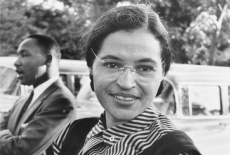
One crucial difference between the Barbary’s form of slavery and the slavery that went on in America, and this must be stressed, is that slaves were often released in the Barbary states after a certain period of time. In America, you were a slave for life and any children you had also became slaves after you.
This relatively unknown piece of Black History is given further importance as Paul Baepler states in his book White Slaves, African Masters that President Lincoln’s stance upon slavery was changed by the memoirs of an American who had escaped the Barbary privateers, as well as the attitudes of many other Americans. Through this new found empathy for the enslaved, Lincoln thereby passed the Emancipation Proclamation in 1863, freeing millions of the slaves in the United States.
So, where are we now and how are we progressing? Barack Obama has become the first black president of the United States and in 2012 was re-elected for another four years, making him one of the most powerful men in the world. Compare that to fifty years ago when he would have been forced to stand up for a white person on a bus.
South Africa will be celebrating 20 years since the end of the apartheid next year; however, having visited the country in 2008 the damaging effects of the apartheid still linger heavily. Almost all the people you see living on the street are black and have often turned to drinking heavily or taking drugs to ease their suffering. Furthermore, if you are a black woman you are considered to be at the bottom of the social hierarchy, so your word will not be taken over that of a white man. So, although there is political equality and universal suffrage in South Africa, much needs to be done to eradicate social injustice.
And whilst slavery is not as tied to race as it was back in the nineteenth century, slavery (though different from the sort of slavery experienced by black people in America) is still far too prevalent across the globe. The Global Slavery Index reported a few months ago that there are about 45 million people living in slavery today in 2016.
Britain’s multicultural sphere is also being shaken up, with the reported rise of anti-Muslim bigotry since 9/11 and the Islamist attack on Private Lee Rigby earlier this year people are arguably becoming more suspicious of outsiders. These shifts could have unpredictable consequences for all ethnic groups in Britain. Suspicion of outsiders, however, is perhaps even more pronounced in America, as Donald Trump’s anti-immigrant message is touching a raw nerve among many Americans – many of whom reportedly feel like they’ve been ignored by America’s political class for years, if not decades. And to specifically address the position of black people in America, it is clear that they still do not enjoy full equality – the most obvious sign of this being their treatment by police, as well as in their justice system. But groups such as Black Lives Matter are attempting to fight back against the racism which seems inherent in parts of these key institutions. Their fight for equal treatment in society is not over yet.
Sources: - http://news.bbc.co.uk/1/hi/world/africa/6445941.stm
- http://www.nytimes.com/2016/06/01/world/asia/global-slavery-index.html?_r=1
Image: See page for author [Public domain], via Wikimedia Commons

0 Comment:
Be the first one to comment on this article.